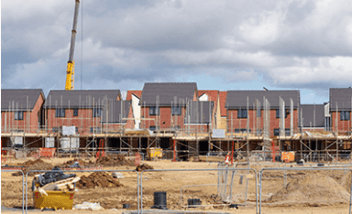Aside from the most obvious benefits we have already covered in detail before – notably the potential for capital appreciation combined with the ability to yield a steady income – there are several other compelling reasons you should be considering taking advantage of the mid-market real estate development opportunity.
With mid-market projects by definition falling in the range between what individual investors would consider at one end of the spectrum, and large institutional investors at the other, there is real value to be found hunting in this underserved but vital sector of the national market.
1. Highly resistant to macro shocks
The UK’s residential property market, despite predictions of plummeting house prices and general chaos during the early stages of the pandemic, has not only emerged unscathed from Covid disruption, but has actually gone on to roar ahead to new highs.
This is symptomatic of a general resiliency within the sector, which investors feel confident is set to continue.
In another sense, the mid-market commercial real estate sector has shown itself to be similarly resilient to another threat – the rise of e-commerce and the resultant threat to the high street. Whilst it is too early to make any firm predictions on this, the long-predicted death of the high street has as yet not taken place, and mid-sized commercial real estate has proved itself to be remarkably resilient.
This is heavily caveated by the statement that results on this front look very different depending on whether the occupants were product or service-based businesses, with service-based performing much better and therefore being much more desirable tenants from an owner's point of view, but the point still stands that commercial real estate assets have emphatically not become what analyst term ‘stranded assets’, i.e. assets which little or no value due to the passage of time and technological development.
2. The need for new housing is only going to increase – much of this demand will be met by the rental sector
With house prices rising at some of the fastest rates on record, a natural result has been more and more households relying on rented accommodation.
This further underlines the severity of the need for more build-to-rent housing developments in or close to UK city centres, and due to the limited availability of land, it makes sense that many of these will be mid-sized.
The fact that interest rates are now rising, reversing a decade long pattern where they were either falling or holding steady at record low levels, will make accessing mortgages harder than has been the case in the recent past, further expanding the pool of families who will need to look for rented accommodation.
3. City centres shed their residents, suburbs swell, but it’s all real estate
It’s hard to know how long the rush from the cities to the countryside induced by the pandemic will last, or whether or not this will prove to be a permanent feature of demand in the UK housing market.
However, the answer to this question is hardly relevant to the investor holding a diverse range of real estate investments. Whilst individual projects may be exposed to the risk that consumer tastes and preferences change, leaving a development less desirable now than anticipated when the project was launched, the asset category as a whole is impervious to this.
As with any portfolio, the key is to diversify and spread the risk – in this case, geographic diversification would be key to mitigating the risks.
4. Sub-categories of housing set to enjoy booming demand
Following on from the point above, whilst the overall category of real estate looks solid, there are several sub-categories that we predict will race ahead of the sector average in the coming years.
Two notable examples of this are student and retirement housing.
Both serve sections of the general population that are set to expand over the next decades, with major demographic shifts already underway, and both represent what economists term price inelastic demand. This means that they have a strong need and willingness to pay for the good in question, making their demand less sensitive to price changes.
In the case of students, the need to be near their university and/or work location is paramount, and in the case of retirees receiving good quality care in a location close to their family and friends trumps other concerns when selecting a care home.
The wealth of the generation due to retire in the coming years is another factor making mid-market care home developments yet another sub-category well worth examining from an investor's point of view.
5. Accommodating ESG concerns
Lastly, the mid-market development is just about the right size for ESG concerns to be fully taken into account in the design and construction of the sites.
Sustainability has certainly moved up the agenda for investors of all types, and mid-sized build-to-rent housing is actually in a strong position to address these concerns. New technologies which make houses more eco-friendly to run are coming to the market all the time, and it is often much easier and more cost-efficient to integrate these into properties when they are being built, rather than retrofitting them later.
Importantly, we are starting to see a clear link emerge between ESG ratings and valuations, and medium-sized developments are fully capable of taking ESG issues into consideration at every stage of the project without jeopardising profitability.




















